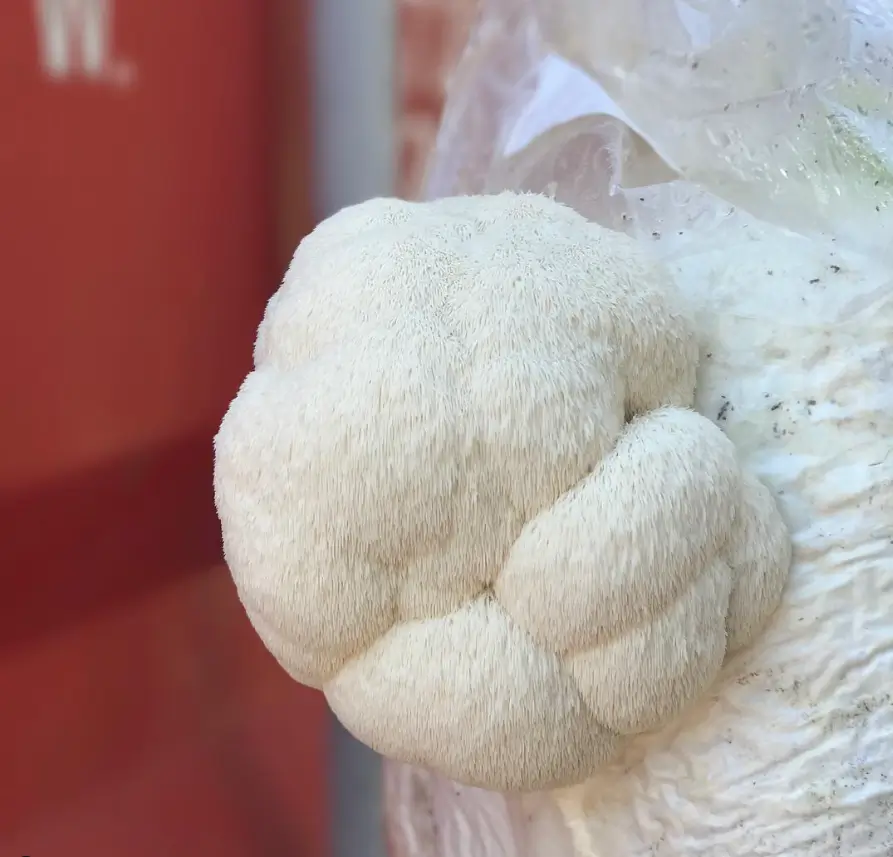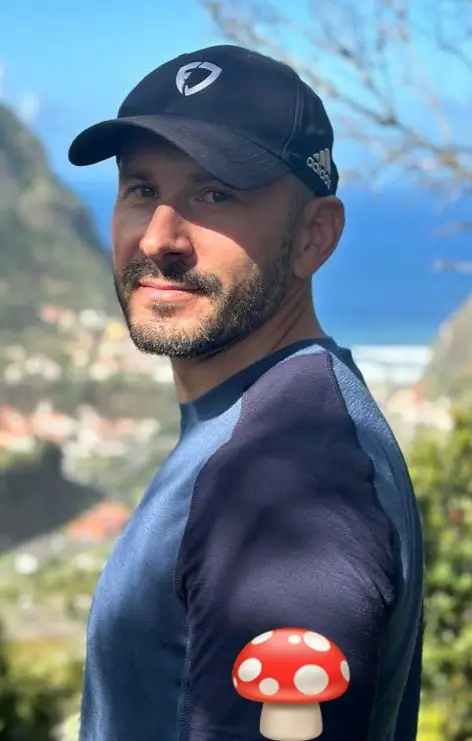Everything you need to successfully grow lion’s mane mushrooms in buckets, bags, or on logs
You’ve probably seen those stunning white, shaggy mushrooms that look like a cheerleader’s pom-pom and wondered if you can grow lion’s mane at home. The answer is yes – but you’ll need the right approach. Here’s exactly how to grow these brain-boosting beauties, whether you’re working indoors or out in your backyard.
How fast does lion’s mane grow at home?
When you’re growing lion’s mane mushrooms, patience pays off. These aren’t your typical fast-growing oyster mushrooms. According to Cornell University’s Small Farms Program, lion’s mane (Hericium erinaceus) takes about 3-4 weeks from inoculation to harvest when grown indoors at 65-75°F (18-24°C).
Here’s your timeline:
- Colonization: 14-21 days after inoculation
- Pinning: 5-7 days after introducing fruiting conditions
- Harvest ready: 7-14 days after pins appear
- Total time: 26-42 days for your first mushrooms
The North American Mycological Association (NAMA) notes that once established, you can harvest every 2-3 weeks for multiple flushes.
What you need to know about lion’s mane growth stages
You’ll see white mycelium spreading like a web through your substrate first. When it looks like cottage cheese forming on the surface, you’re close to fruiting. Those tiny white bumps will transform into full mushrooms faster than you’d expect – sometimes doubling in size within 24 hours during the final stage.
Safety Warning
- Never eat wild mushrooms without 100% positive identification by an expert
- Join your local mycological society for hands-on training
- Even experienced foragers can mistake toxic species for edible ones
Where does lion’s mane grow naturally?
Before you start growing lion’s mane at home, it helps to understand where these mushrooms thrive in nature. You’ll find wild lion’s mane on dead or dying hardwood trees throughout North America, Europe, and Asia.
Lion’s mane prefers:
- Oak trees (all species)
- Maple, beech, and birch
- Wounds on living trees
- Dead logs and stumps
- Temperatures between 55-75°F (13-24°C)
Mycologist Paul Stamets reports in “Growing Gourmet and Medicinal Mushrooms” that lion’s mane fruits from July through February depending on your region – earlier in cooler climates, later in warmer areas.
Is lion’s mane easy to grow for beginners?
Here’s the honest truth: lion’s mane isn’t the easiest mushroom for your first growing project. The mycelium develops slower than oyster mushrooms, giving contamination more time to take hold. Dr. Tradd Cotter from Mushroom Mountain recommends starting with oyster mushrooms first, then moving to lion’s mane once you’ve got the basics down.
That said, you can absolutely succeed with lion’s mane if you:
- Keep everything super clean
- Monitor temperature closely at 65-75°F (18-24°C)
- Maintain humidity at 85-95%
- Use a pre-made growing kit for your first attempt
Best substrate for lion’s mane mushrooms
You’ll get the best results with Masters Mix – a 50/50 blend of hardwood pellets and soy hulls. Research from the University of Wisconsin shows this combination produces 25% higher yields than plain sawdust.
Your substrate options ranked by success rate:
- Masters Mix (hardwood pellets + soy hulls)
- Supplemented hardwood sawdust with 10-20% wheat bran
- Pure hardwood sawdust (oak or maple preferred)
- Straw pellets supplemented with 20% bran
Mix your substrate to 60-65% moisture content. Too wet and you’ll get contamination. Too dry and the mycelium stalls out.

How to grow lion’s mane mushrooms indoors
You can grow lion’s mane in buckets, bags, or containers. Here’s your step-by-step process for growing lion’s mane indoors:
Step 1: Prepare your growing containers
For bucket growing (most popular method):
- Drill 1/4-inch (6mm) holes every 4-6 inches (10-15cm) around a 5-gallon (19-liter) bucket
- Cover holes with micropore tape until colonization
For grow bags:
- Use 5-pound (2.3kg) filter patch bags
- Fill leaving 4 inches (10cm) of headspace
Step 2: Mix and sterilize substrate
You’ll need to sterilize everything to prevent contamination:
- Mix 5 pounds (2.3kg) hardwood pellets with 5 pounds soy hulls
- Add 1.4 gallons (5.3 liters) water
- Load into bags or buckets
- Pressure cook at 15 PSI for 90 minutes
- Cool to 75°F (24°C) before inoculating
Step 3: Inoculate with lion’s mane spawn
Work in the cleanest area you’ve got:
- Add spawn at 10-15% of substrate weight
- Mix thoroughly
- Seal containers
Step 4: Incubation and colonization
Keep your containers at 70-75°F (21-24°C) in darkness. You’ll see white mycelium spreading within 3-5 days. Full colonization takes 14-21 days.
Step 5: Initiate fruiting
When fully white, it’s time to fruit:
- Drop temperature to 60-65°F (15-18°C)
- Increase humidity to 90-95%
- Provide indirect light 12 hours daily
- Remove tape from holes or cut slits in bags
Growing lion’s mane on logs outdoors
Log cultivation takes longer but produces for years. The Mushroom Cultivation Handbook by Peter Oei confirms logs can fruit for 4-6 years once established.
Your log growing process:
- Select fresh hardwood logs
- 4-8 inches (10-20cm) diameter
- 3-4 feet (0.9-1.2m) long
- Cut during dormant season
- Drill and inoculate
- Drill 5/16-inch (8mm) holes 6 inches (15cm) apart
- Insert plug spawn
- Seal with wax
- Stack in shade
- Keep moist but not soaked
- Wait 6-12 months for colonization
- Force fruiting
- Soak logs 24 hours in cold water
- Stand upright
- Fruit in 1-2 weeks
Growing lion’s mane in buckets outdoors
You can also grow lion’s mane in buckets outside:
- Use the same bucket prep as indoor growing
- Place in shaded area after colonization
- Natural temperature swings often trigger fruiting
- Cover during heavy rain
When to harvest lion’s mane mushrooms
Timing your harvest makes the difference between prime mushrooms and disappointment. You’ll know lion’s mane is ready when the teeth (spines) are 1/4 to 1/2 inch (6-12mm) long and the mushroom stops expanding.
Signs it’s harvest time:
- Spines elongated but still white
- Feels firm like a damp sponge
- No yellowing or browning
- Before spore release (white powder)
How to harvest: Don’t use a knife – it damages the mycelium. Instead, grasp the base and twist while pulling. Remove the entire mushroom to prevent contamination.
How long does it take to grow lion’s mane? (Timeline summary)
Indoor growing:
- Substrate prep to harvest: 3-4 weeks
- Between flushes: 2-3 weeks
- Total flushes possible: 2-3
Log cultivation:
- Inoculation to first fruit: 1-2 years
- Production lifespan: 4-6 years
- Flushes per year: 1-2 (spring and fall)
Lion’s mane growing temperature and conditions
Temperature control determines your success. Research from the Journal of Agricultural Technology shows lion’s mane has specific requirements:
Colonization phase:
- Temperature: 70-75°F (21-24°C)
- Humidity: 60-70%
- No light needed
Fruiting phase:
- Temperature: 60-65°F (15-18°C)
- Humidity: 85-95%
- Light: 100-200 lux (indirect daylight)
Common problems and solutions
Yellow or brown mushrooms: Lower temperature to 60°F (15°C) and increase fresh air
No pins forming: Check humidity – needs 90%+ to initiate
Contamination: Green or black mold means start over with better sterilization
Slow growth: Increase temperature during colonization, decrease during fruiting
Storage tips for your harvest
Fresh lion’s mane lasts 5-7 days in a paper bag in your refrigerator at 34-38°F (1-3°C). For longer storage:
- Slice and dehydrate at 115°F (46°C)
- Freeze after blanching 2 minutes
- Make tinctures or powder
Frequently asked questions about growing lion’s mane
Q: How long does it take to grow lion’s mane mushrooms at home?
A: Indoor growing takes 3-4 weeks from inoculation to harvest at 65-75°F (18-24°C). Log cultivation takes 1-2 years for first fruits.
Q: What’s the best substrate for lion’s mane mushrooms?
A: Masters Mix (50/50 hardwood pellets and soy hulls) gives highest yields. Supplemented hardwood sawdust with 10-20% wheat bran works well too.
Q: Can you grow lion’s mane in a bucket?
A: Yes! Drill 1/4-inch holes every 4-6 inches around a 5-gallon bucket. This method works great indoors or outdoors in shade.
Q: When should I harvest lion’s mane?
A: Harvest when spines reach 1/4 to 1/2 inch long and the mushroom stops expanding but before any yellowing appears.
Q: Is lion’s mane easy to grow for beginners?
A: Lion’s mane is moderately difficult due to slow colonization. Start with a kit or try oyster mushrooms first to learn basics.
Helpful resources for growing lion’s mane at home
- North American Mycological Association (NAMA)
- “Growing Gourmet and Medicinal Mushrooms” by Paul Stamets
- Cornell Small Farms Program – Mushroom Cultivation
- Your local mycological society for hands-on workshops
- Mushroom Mountain Research
Now you know exactly how to grow lion’s mane mushrooms at home. Start with a growing kit if you’re new to mushroom cultivation, then move to making your own substrate once you’ve got some experience.
Your next step: Order lion’s mane spawn and gather your supplies – you’ll be harvesting your own brain-boosting mushrooms in just 3-4 weeks!





